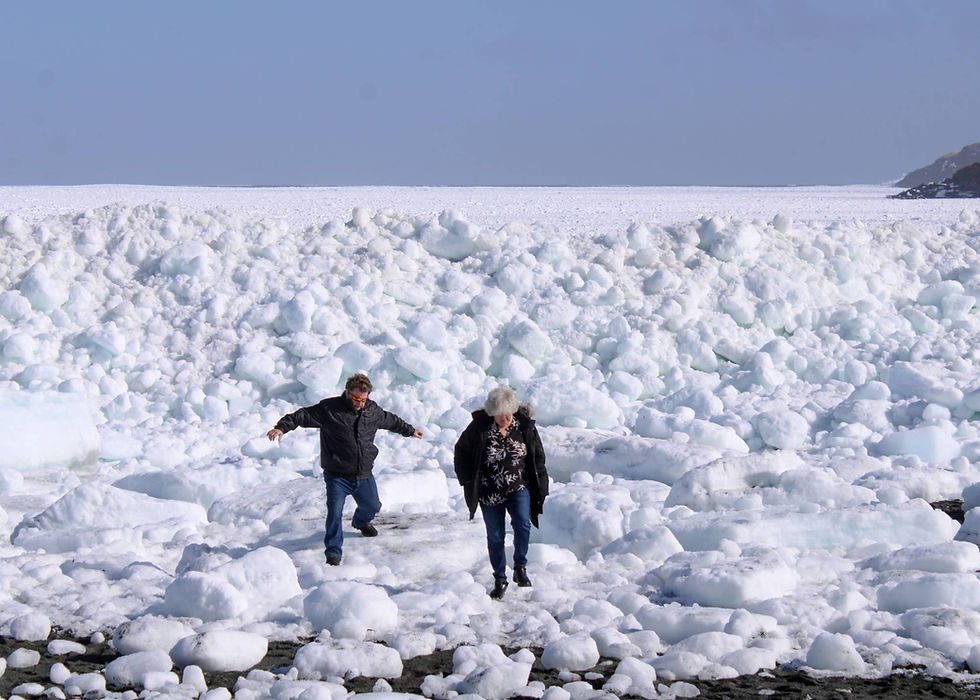- Sandra Murray

- Dec 3, 2021
- 3 min read
Updated: Mar 15, 2023
Iceberg Tracking
Icebergs are quite a popular tourist attraction in Newfoundland and best seen between the months of May and June. However, the ability to predict where, and when, icebergs will appear is virtually impossible. For real time iceberg reports and information, follow the Iceberg Finder app.

Iceberg formation and travel
Most of the icebergs that are seen in Newfoundland originate in the Arctic region of Greenland, a travel distance of about 3369 km from the city of St. John's. There, over the course of about 15,000 years, countless layers of fallen snow have been compressed into glacial ice, which now covers 3/4 of the island.

In response to continued downward & outward pressure upon the glacial ice sheets, the edges of the mass snap off and are swept into the ocean, giving birth to an iceberg. From there, the north-south direction of the ocean's current propels the icebergs into the Labrador sea where as many as 98% will melt or become eroded by ocean waves. Those that do survive are carried further downward along the shores of Newfoundland following a pathway knows as Iceberg Alley.

The iceberg's journey will come to an end in the warmer ocean waters of Newfoundland.

Why do icebergs float and how fast do they move?
Icebergs are made of snow (pure water) and, because fresh water is lighter than salt water, the iceberg will float. There are many things that determine how fast the iceberg will move, including:
The size and shape of the iceberg
The ocean current
Winds
Water temperature (which, in turn, influences melting)
The degree to which the route is clear from pack ice

Why does an iceberg look dirty if it's supposed to be pure?
Icebergs are created from snow which is pure and relatively free from pollutants. However, due to exposure to land, birds, and dust particles in the air, some of the iceberg's surface may contain foreign particles.

Icebergs: More than meets the eye
When viewing icebergs, it is impressive to consider that we are only viewing about 10% of the iceberg's true size. This is because there is a density difference of about 10% between fresh water (from which the iceberg is formed) and the salt water found in the ocean. Check out this fun activity to get an idea of how much of an iceberg is actually concealed underwater.

Icebergs: No two alike
Icebergs vary considerably in terms of shape and size. In fact, no two icebergs are exactly alike and, due to melting and erosion, no iceberg is the same from day to day. However, icebergs can be classified in relation to their shapes:
Tabular: an iceberg with a flat bottom that is five times longer than its height
Blocky: an iceberg with steep sides with a flat top that resembles a block
Wedged: an iceberg with one steep side sloping toward a shorter side
Dome: an iceberg with a rounded top
Pinnacle: an iceberg with at least one pointed peak
Dry Dock: an iceberg that has at least 2 peaks divided by an eroded channel
Sometimes icebergs can be heard making a fizzing sound which is caused by the releasing of trapped air when the iceberg begins to melt.

Iceberg caution
Because an iceberg's center of gravity changes often due to melting and erosion, caution must be exercised when viewing them as they can flip or break apart without warning. A safe distance must be kept from icebergs to reduce the risk of injury.

Iceberg photography
Be sure to take advantage of icebergs as amazing subjects to use in your nature photos during your time in Newfoundland. Mother Nature provides the best filters imaginable for unique iceberg photos.







Iceberg fun: What do you see?
I've always enjoyed looking at icebergs and comparing them with things of similar shapes. Do you see what I see in the following pictures?


In Newfoundland, you can even drink an iceberg!
Located in St. John's, Newfoundland, Quidi Vidi Brewery uses iceberg water instead of tap water in its alcoholic beverages.

Please continue to follow my blog as I showcase more amazing tourist attractions in eastern Newfoundland.




Comentarios